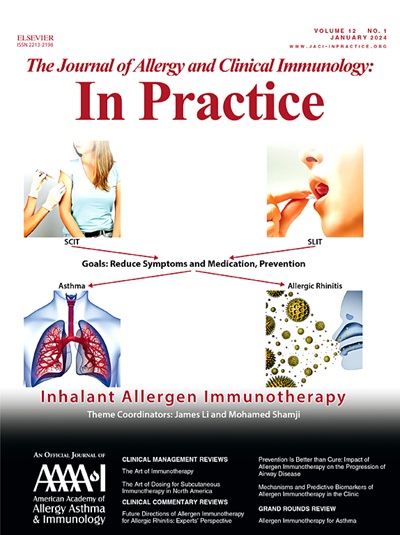Long-Term Efficacy and Safety of Benralizumab Treatment for PDGFRA-Negative Hypereosinophilic Syndrome
IF 8.2
1区 医学
Q1 ALLERGY
Journal of Allergy and Clinical Immunology-In Practice
Pub Date : 2025-06-01
DOI:10.1016/j.jaip.2025.03.016
引用次数: 0
Abstract
Background
Therapies for hypereosinophilic syndromes (HES) have variable efficacy and significant toxicity. Benralizumab (BENRA), an afucosylated monoclonal antibody that binds interleukin 5 receptor α expressed on eosinophils, reduced blood and tissue eosinophils in a 48-week, phase 2 study in PDGFRA-negative HES.
Objective
To assess safety and efficacy of long-term BENRA treatment in PDGFRA-negative HES.
Methods
Twenty PDGFRA-negative HES patients with severe and diverse clinical manifestations were treated in a double-blind, placebo-controlled clinical trial of BENRA (NCT02130882). Fourteen were followed on an open-label extension. Efficacy and safety were reviewed at each visit.
Results
Among 14 long-term participants, 3 withdrew owing to loss of efficacy, and 1 owing to death unrelated to drug after 2 to 6 years. The remaining 10 participants received BENRA for at least 8 years (maximum exposure 10.1 y). Peripheral eosinophil counts remained suppressed in all participants. Eight participants attempted to taper from monthly to every-2-month dosing, of which 5 resumed monthly dosing owing to increased symptoms and/or eosinophil count. There were 11 serious adverse events: 10 hospitalizations (3 for infections, 5 for surgeries, and 2 for drug desensitization or observation) and 1 death from antibiotic-associated toxic epidermal necrolysis. None were attributed to BENRA. Eight participants reported injection-site reactions (23 total), all mild in severity and self-limited. Three malignancies and no parasitic infections were reported. Despite sustained eosinophil depletion, immunoglobulin levels and peripheral T-, B-, and natural killer–cell counts were stable for the duration of the study.
Conclusions
Long-term BENRA therapy is effective and well-tolerated in HES patients without significant adverse effects.
Benralizumab治疗pdgfr阴性嗜酸性粒细胞增多综合征的长期疗效和安全性。
背景:高嗜酸性粒细胞综合征(HES)的治疗具有不同的疗效和显著的毒性。Benralizumab是一种结合il - 5- r α表达在嗜酸性粒细胞上的聚焦单克隆抗体,在一项为期48周的pdgfr阴性HES 2期研究中降低了血液和组织嗜酸性粒细胞。目的:评估苯那利珠单抗长期治疗pdgfr阴性HES的安全性和有效性方法:采用双盲、安慰剂对照的苯那利珠单抗(NCT02130882)治疗20例pdgfr阴性HES患者,这些患者具有严重和不同的临床表现。其中14人接受了开放标签延长治疗。每次就诊时均对疗效和安全性进行评估。结果:14例长期受试者中,3例因疗效丧失而退出,1例因2 ~ 6年后与药物无关的死亡而退出。其余10名受试者接受贝纳利珠单抗治疗至少8年(最长10.1年)。所有参与者的外周嗜酸性粒细胞计数仍然受到抑制。8名参与者试图从每月给药逐渐减少到每2个月给药一次,其中5名由于症状和/或嗜酸性粒细胞计数增加而恢复每月给药。11例严重不良事件:10例住院(3例感染,5例手术,2例药物脱敏或观察),1例因抗生素相关的中毒性表皮坏死松解而死亡。没有一例归因于贝纳利珠单抗。8名参与者报告了注射部位的反应(总共23人),均为轻度且自限性。恶性肿瘤3例,未见寄生虫感染。尽管持续的嗜酸性粒细胞耗竭,免疫球蛋白水平和外周T、B和NK细胞计数在研究期间是稳定的。结论:长期苯那利珠单抗治疗HES患者有效且耐受性良好,无明显不良反应。
本文章由计算机程序翻译,如有差异,请以英文原文为准。
求助全文
约1分钟内获得全文
求助全文
来源期刊

Journal of Allergy and Clinical Immunology-In Practice
ALLERGYIMMUNOLOGY-IMMUNOLOGY
CiteScore
11.10
自引率
9.60%
发文量
683
审稿时长
50 days
期刊介绍:
JACI: In Practice is an official publication of the American Academy of Allergy, Asthma & Immunology (AAAAI). It is a companion title to The Journal of Allergy and Clinical Immunology, and it aims to provide timely clinical papers, case reports, and management recommendations to clinical allergists and other physicians dealing with allergic and immunologic diseases in their practice. The mission of JACI: In Practice is to offer valid and impactful information that supports evidence-based clinical decisions in the diagnosis and management of asthma, allergies, immunologic conditions, and related diseases.
This journal publishes articles on various conditions treated by allergist-immunologists, including food allergy, respiratory disorders (such as asthma, rhinitis, nasal polyps, sinusitis, cough, ABPA, and hypersensitivity pneumonitis), drug allergy, insect sting allergy, anaphylaxis, dermatologic disorders (such as atopic dermatitis, contact dermatitis, urticaria, angioedema, and HAE), immunodeficiency, autoinflammatory syndromes, eosinophilic disorders, and mast cell disorders.
The focus of the journal is on providing cutting-edge clinical information that practitioners can use in their everyday practice or to acquire new knowledge and skills for the benefit of their patients. However, mechanistic or translational studies without immediate or near future clinical relevance, as well as animal studies, are not within the scope of the journal.
 求助内容:
求助内容: 应助结果提醒方式:
应助结果提醒方式:


